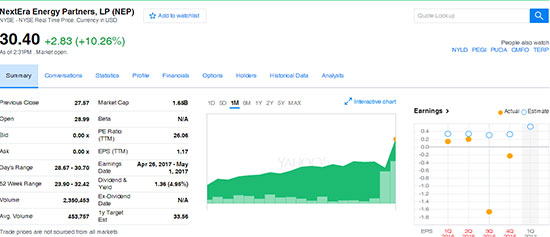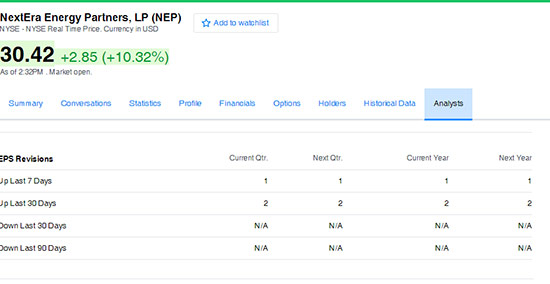We all know that, more than anything else, earnings drive share prices. And anyone can see the impact of an "earnings beat" on a company's stock.
Just look at the way the financial media will dissect the information and report the highlights - sometimes to the point of redundancy.
That's fine, but there's another earnings event - one far off the media's radar - that is much more powerful, like a "spark" that can ignite massive gains for those who know how to spot it.
That's why I want to show you how to find it today. It'll help you make more money, but you'll also get into position ahead of Wall Street's biggest investors.
This "Spark" Can Ignite Massive Gains
Like I said, earnings season grabs financial headlines, but analysts' upward earnings revisions just don't get much press.
That's mostly because earnings revisions aren't as sexy as when a company like Apple Inc. (Nasdaq: AAPL) blows the doors off expectations.
They can also happen at any time.
Let me show you how analysts come by these numbers, in case you're not familiar with them.
An analyst identifies a catalyst that has yet to be priced into the market. These catalysts could be any one or a combination of improving trends in recent earnings, or upbeat management comments to the public, or the announcement of a key contract or new technology, or an improvement in the macro-economic condition of an entire industry, just to name a few.
Once the analyst identifies the catalysts, he can go to work crunching the numbers in order to come up with new projected earnings and price targets.
Now, it doesn't really matter why the estimate was revised - as long as it's logical and supports well the contention that the potential for future profits is greater than it was before.
Once the estimate is revised, the analyst puts together a report - complete with the rationale behind the improved estimates - and sends it out to institutional investors and preferred clients.
The new estimate is added to the existing group of estimates, and an average consensus estimate is generated.
When the consensus estimates are improving, it indicates analysts are expecting earnings to improve - and that catches the eye of institutional investors (or the "Big Boys," as I like to refer to them) who have literally trillions of dollars to invest.
This is where the fun starts...
[mmpazkzone name="end-story-hostage" network="9794" site="307044" id="138536" type="4"]
Put Wall Street's Big Boys to Work for You
Unlike you and me, the Big Boys can't just go out and establish an entire position in the click of a button or a single call to a broker. Instead, they need to strategically build that position over time in order to not push the price up too high, too fast.
Because of that, it can take institutional investors weeks - and even months, in some cases - to fully build a position.
Now, multiply one institutional investor by 10, 20, or more and you've got a rally under way that can last months and push a stock price to new highs - making a lot of money for investors who were savvy enough to get in ahead of them.
That's one of the goals in my Delta Factor trading service - to get in ahead of the Big Boys and establish positions in exciting small-cap opportunities. And one of my favorite strategies is to focus on companies with improving earnings estimates.
It's really pretty straightforward. If earnings are being revised to the upside, then there is a pretty darn good chance that there is a new catalyst pushing those revisions higher.
My team uses a lot of (expensive) data feeds in order to track earnings estimate trends - but you can track them on a company-specific level using a free service such as Yahoo Finance.
Let me show you how...
Profit Potential Couldn't Be Easier to Find
Enter the ticker of a company you're interested into Yahoo Finance's Look Up box. That takes you to a page with a summary of the company.
Most people understand that much, already. It's what comes next that might be new to you...
Once you're on the summary page, look a little less than halfway down the page to a group of nine tabs. On the far right you'll see the "Analysts" tab - click it.
Let's use NextEra Energy Partners LP (NYSE: NEP), a utility, as an example:

Once you've clicked on the "Analysts" tab, scroll down the page a little further until you see the heading "EPS Revisions"
What we see when we look at shares is that analysts have upwardly revised current-year (January 2017) earnings once in the past week and twice in the past 30 days.

That's pretty darn good, and it probably has a lot to do with why the stock has climbed nearly 19% since Jan. 4.
I'm only using NextEra as a demonstration because of the recent analyst upgrades. I'm not making a recommendation one way or the other.
But now that you see the correlation between earnings estimates and performance, I invite you to look at some of your favorite stocks and see how the analyst community is viewing them.
If you see an improving trend over the last week or month, you could experience improved performance in the stock, i.e., you might make more money - which of course we all like to see.
On the other hand, if a company you're currently holding in your portfolio is experiencing a wave of downward revisions, you might want to consider selling it or, at the very least, tightening up your trailing stop.
Speaking of trailing stops, we'll wrap up today with a quick discussion of how to effectively use them.
Common wisdom thinks of a trailing stop as a way to protect your downside - and that's absolutely correct.
But what most investors overlook is that using trailing stops is a great way to capture profits on your winners, too.
Instead of using typically losing strategies, like second-guessing or attempting to time the market, it's much easier to initiate a trailing stop, strategically tighten it up as your position increases in value, and then let the stop take you out - hopefully with a tidy profit along the way.
The technique Sid shared with us today is just one way he spots small caps about to soar. To see the latest discovery from Sid's intensive small-cap research - where the top trades alone average 366% gains - just go here.
Follow Money Morning on Facebook and Twitter.
About the Author
Sid is the investment community's best-kept secret. Since 2009, he's served at Money Map Press as Director of Research, analyzing thousands of securities and profit opportunities for subscribers. He's an expert in identifying "alpha" potential in a wide variety of industries, but especially the small-cap sector, where he's discovered a pattern of profits that's almost foolproof.



